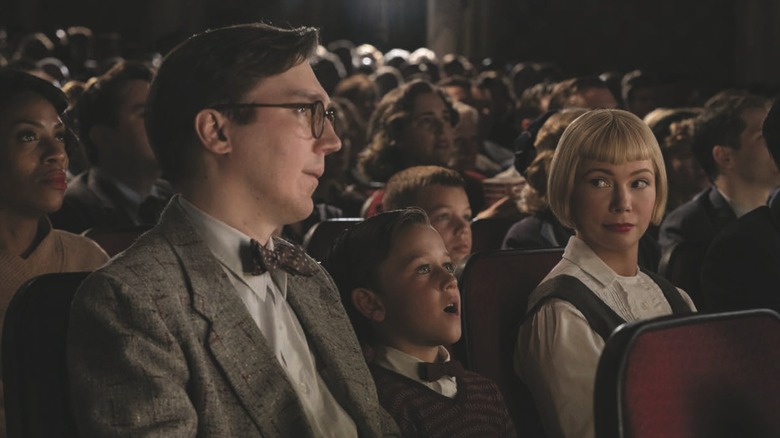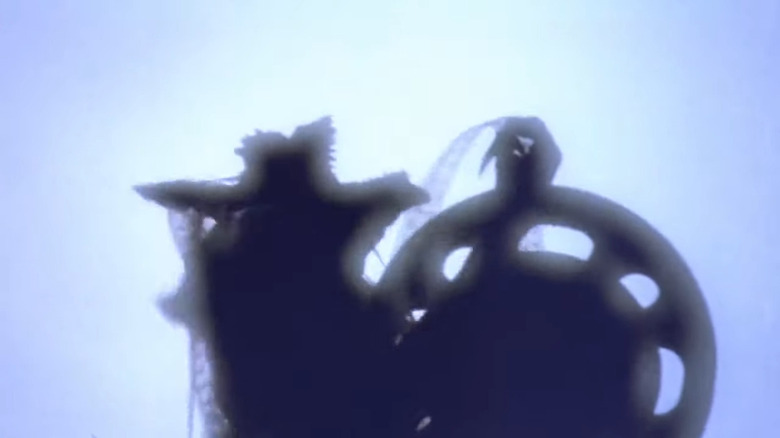How The Fabelmans Poster Gets Actual Film All Wrong
Steven Spielberg's new film "The Fabelmans" will be released in theaters on November 11, 2022. It tells a semi-autobiographical story of Spielberg's own childhood, and how he and his on-screen avatar (Gabriel LaBelle) share a mutual passion for film. It appears to be the latest in a currently-cresting wave of nostalgia-based movies that re-create very specific details from the director's own childhood (see also: "Belfast," "Roma," "Licorice Pizza," "Once Upon a Time in... Hollywood," and "Apollo 10 ½: A Space-Age Childhood").
A poster for "The Fabelmans" was just released out of the Toronto International Film Festival, and, golly. Whoever designed the poster certainly knows a lot less about film than Steven Spielbergs.
The poster features a young boy in silhouette, walking through a studio lot. In the sky above his head are several outside film strips that depict, in each frame, a memory from his life. Each of the film's cast members can be seen in the celluloid memories, including Michelle Williams, Paul Dano, and La Belle himself. While one can see the meaning of the poster — memory and cinema are but one and the same — those who have worked with 35mm will become antsy almost immediately. Everything about those film strips, just at first glance, is incredibly wrong. If one wants to evoke the hefty, visceral experience of handling an old 35mm film strip, then maybe one ought to ensure accuracy.
It is time, dear reader, to nitpick.
24fps
The first gaffe will be evident even to those who have not ever touched 35mm film: the frequency of the images. When film was invented, there was an early experimental phase when engineers had yet to determine how quickly film should run through a camera. After all, film is nothing more than a series of still images, printed on film stock or played rapidly from a digital source, played in a set sequence, forcing the eye to blend the images together. It creates the illusion of movement. After some tinkering, it was eventually determined that the illusion of movement could be achieved with a minimum of 24 frames per second.
Recently, filmmakers like Ang Lee and Peter Jackson have been experimenting with increased frame rates, but after over a century of 24fps, most audiences are trained to see it as standard. Something most people may not know is that a foot of 35mm film is 16 frames long. A projectionist can use a frame counter to measure the length of a standard film reel (a reel, on average, is under 2000 feet) and then use a film calculator to determine its length in minutes.
The mess on "The Fabelmans" poster shows several images in rapid succession. Unless the film on the poster is meant to be a scattershot barrage of images, none of the scenes in question will appear cogent to the human eye.
Framing
Another thing even the untrained eye will notice is that the frame sizes are all off. Frames on 35mm film strips are only going to be four perforations in height. 70mm film, can be five perfs. IMAX film runs through a projector not top-to-bottom, but side-to-side, with perfs on the tops and bottoms of the film image stretching to a whopping 15 perfs.
The perfs on this poster are all different heights, with some being seven perfs and some being five. What's with this willy-nilly printing? You want that to fall out of frame?? And before you start to argue that it may be a sideways image for a 2.39:1 aspect ratio, let me remind you that Scope images are compressed and distorted on a film strip, only to be "uncompressed" by use of a Scope lens. Those film strips do not have a compressed image, and are, therefore, flat images meant to be seen in 1.85:1, 1.66:1, or 1.37:1 aspect ratios.
As it so happens, "The Fabelmans" was shot on a special three-perf 35mm film and 16mm film, and will be shows in 1.85:1.
Also, the line in between the frames have to, by necessity, fall in between the perfs. On the upper left of the poster, one can see a frame line that overlaps with a perf. A next-to-perf frame line is typically the result of a printing error, and will cause the image to fall out of frame during projection. If you've ever seen a sliver of image at the top or bottom of the screen during a movie, it means that the projectionist hasn't framed up the film properly. Sometimes that is projectionist's error, as they failed to adjust the framing knob. In the case of "The Fabelmans" poster, it's just a bad print.
Sound formats
Also, a quick glance at the 35mm film strips on the poster will reveal that the film strips have no soundtrack. Indeed, the image goes right up to the perfs on either side, meaning a sound reader would have to be switched off entirely to accommodate.
A mono soundtrack strip usually rests between the image and perfs on the right side of the image. Mono tracks can look one of several ways. Some mono tracks look like a strip of alternating grayscale. Those are called variable density tracks. Other mono tracks, optical tracks, have a "Richer scale" looking white squiggle. There can be one, two, or even five mono tracks. If the squiggles are all the same, the audience will hear the same audio information coming from each speaker in the theater. If the squiggles differ, then it is likely a Dolby stereo print, with different information making its way to separate audio channels.
"The Fabelmans" is clearly not dealing with digital audio tracks, otherwise one might have to look for a hazy Dolby track in between the perfs, a "Morse code" looking track for DTS (remember DTS? The ones that played their sound from compact discs). Or, in certain cases, the sound could appear as two digital tracks on the outer edge of the film. That's for SDDS. Remember SDDS?.
Let's hope that someone fixed these grievous, grievous errors before the film is released, otherwise, no one will be able to take the film seriously.



